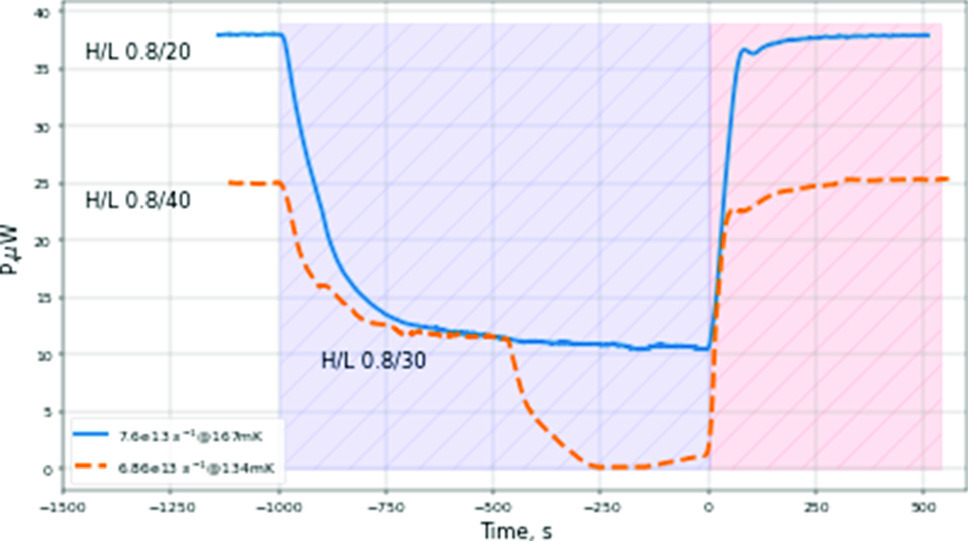https://doi.org/10.1140/epjd/s10053-025-00976-1
Regular Article - Atomic Physics
Cold source of atomic hydrogen for loading large magnetic traps
1
Department of Physics and Astronomy, University of Turku, 20014, Turku, Finland
2
Laboratoire Kastler Brossel, Sorbonne Université, CNRS, ENS-PSL Université, Collège de France, 75252, Paris, France
3
Institut Max von Laue - Paul Langevin, 71 Avenue des Martyrs, 38042, Grenoble, France
4
Stefan Meyer Institute for Subatomic Physics, Austrian Academy of Sciences, Dominikanerbastei 16, 1010, Vienna, Austria
5
Institute for Particle Physics and Astrophysics, ETH Zurich, 8093, Zurich, Switzerland
Received:
19
December
2024
Accepted:
28
February
2025
Published online:
26
March
2025
We present a design and performance tests of an intense source of cold hydrogen atoms for loading large magnetic traps. Our source is based on a cryogenic dissociator of molecular hydrogen at 0.6 K followed by a series of thermal accommodators at 0.5, 0.2 and 0.13 K with inner surfaces covered by a superfluid helium film. All components are thermally anchored to corresponding stages of a dilution refrigerator. The source provides a continuous flux of  H atoms/s in a temperature range of 130–200 mK. We have successfully used the source for loading a large Ioffe–Pritchard magnetic trap recently built in our laboratory (Ahokas et al. in Rev Sci Instrum 93(2):023201, 2022). Calorimetric measurements of the atomic recombination heat allow reliable determination of the atomic flux and H gas density in the trap. We have tested the performance of the source and loading of H atoms into the trap at various configurations of the trapping field, reducing the magnetic barrier height to 75
H atoms/s in a temperature range of 130–200 mK. We have successfully used the source for loading a large Ioffe–Pritchard magnetic trap recently built in our laboratory (Ahokas et al. in Rev Sci Instrum 93(2):023201, 2022). Calorimetric measurements of the atomic recombination heat allow reliable determination of the atomic flux and H gas density in the trap. We have tested the performance of the source and loading of H atoms into the trap at various configurations of the trapping field, reducing the magnetic barrier height to 75 and 50
and 50 of the nominal value of 0.8 T (0.54 K) as well as at the open configuration of the trap at its lower end, when the atoms are in contact with the trapping cell walls covered by a superfluid helium film. In the latter case, raising the trapping cell temperature to 200–250 mK, the low-field seeking atoms at densities exceeding 10
of the nominal value of 0.8 T (0.54 K) as well as at the open configuration of the trap at its lower end, when the atoms are in contact with the trapping cell walls covered by a superfluid helium film. In the latter case, raising the trapping cell temperature to 200–250 mK, the low-field seeking atoms at densities exceeding 10
 can be stored for the time over 10
can be stored for the time over 10 s, sufficiently long for experiments on precision spectroscopy of cold H gas.
s, sufficiently long for experiments on precision spectroscopy of cold H gas.
© The Author(s) 2025
 Open Access This article is licensed under a Creative Commons Attribution 4.0 International License, which permits use, sharing, adaptation, distribution and reproduction in any medium or format, as long as you give appropriate credit to the original author(s) and the source, provide a link to the Creative Commons licence, and indicate if changes were made. The images or other third party material in this article are included in the article’s Creative Commons licence, unless indicated otherwise in a credit line to the material. If material is not included in the article’s Creative Commons licence and your intended use is not permitted by statutory regulation or exceeds the permitted use, you will need to obtain permission directly from the copyright holder. To view a copy of this licence, visit http://creativecommons.org/licenses/by/4.0/.
Open Access This article is licensed under a Creative Commons Attribution 4.0 International License, which permits use, sharing, adaptation, distribution and reproduction in any medium or format, as long as you give appropriate credit to the original author(s) and the source, provide a link to the Creative Commons licence, and indicate if changes were made. The images or other third party material in this article are included in the article’s Creative Commons licence, unless indicated otherwise in a credit line to the material. If material is not included in the article’s Creative Commons licence and your intended use is not permitted by statutory regulation or exceeds the permitted use, you will need to obtain permission directly from the copyright holder. To view a copy of this licence, visit http://creativecommons.org/licenses/by/4.0/.





